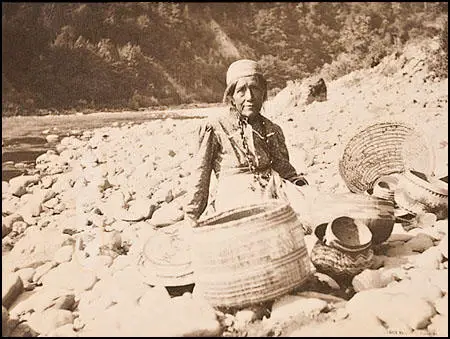Karok
The Karok lived close to the Pacific coastline along the Klamath River. They hunted elk and deer in the Trinity Mountains and gathered acorns in the foothills. According to Evelyn Wolfson: "The Karok followed an annual cycle of fishing, hunting, and wild-food gathering, which provided them with food all year round. They celebrated the salmon's swim upriver in spring by netting or spearing hundreds of spawning fish, many of which they smoked... They also collected a variety of birds, lizards, frogs, grasshoppers."
Stephen Powers argues in his book, Tribes of California (1876): "The Karok are very democratic. They have a headman or captain in each rancheria, though when on the war-path they are in a slight degree subject to the control of one chief…In war they do not take scalps, but decapitate the slain and bring in the heads as trophies. They do battle with bows and arrows, and in a hand-to-hand encounter, which often occurs, they clutch ragged stones in their hands and maul each other with terrible and deadly effect."

The word Karok means "upstream" and helped to distinguish them from the Yurok people who lived "downstream" on the Klamath River. The authors of The Natural World of the California Indians (1980) argue that these two tribes were part of the Northwestern subculture: "Ecologically, it was closely adapted to the rain-forest environment, with its settlements situated along river banks and the ocean coast at stream mouths, lagoons, or bays. The dugout canoe was the most important means of travel, routes being along rivers and the ocean shore. There were trails for foot travel, and these were used to visit neighboring villages; but the canoe remained the best means for travelling any distance and for crossing the Klamath River, which over much of its course is wide, fast-flowing, and deep." Alfred L. Kroeber calculated that in 1770 the Karuk had a population of 1,500.
The Karok traded with fur trappers in the late 18th century. However, they could not cope with the great migrations that took place after the Californian Gold Rush. The Karok used shamans to get rid of the white settlers. Evelyn Wolfson has pointed out: "The Karok initiated the Ghost Dance ceremonies in the effort to rid the world of white people through supernatural means. They believed that the dances would also bring back Indians who knew what the world was like before the whites had come. They also thought the ceremonies would restore their land and resources."
The descendants of the Karok live on a reservation and in communities along the Klamath River. The 2000 census revealed a population of 333 people.
Primary Sources
(1) Stephen Powers, Tribes of California (1876)
The Karok are very democratic. They have a headman or captain in each rancheria, though when on the war-path they are in a slight degree subject to the control of one chief…In war they do not take scalps, but decapitate the slain and bring in the heads as trophies. They do battle with bows and arrows, and in a hand-to-hand encounter, which often occurs, they clutch ragged stones in their hands and maul each other with terrible and deadly effect.
